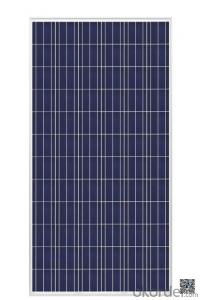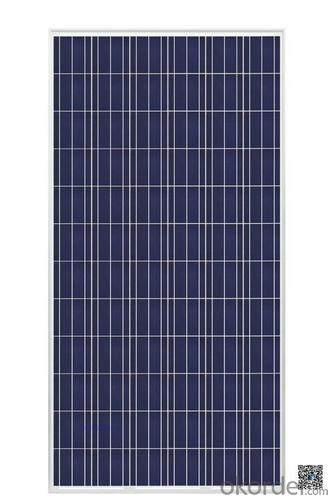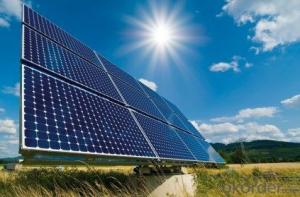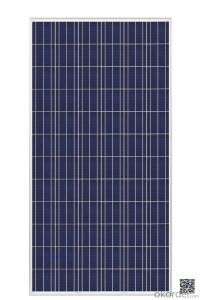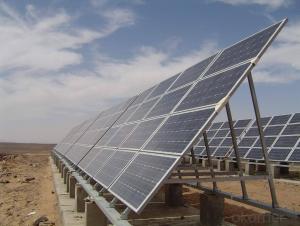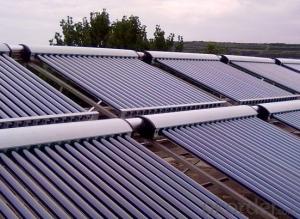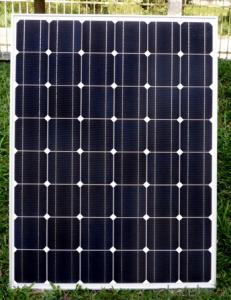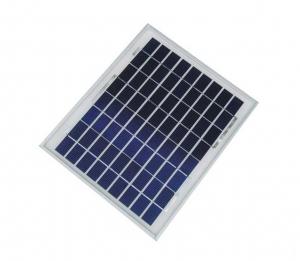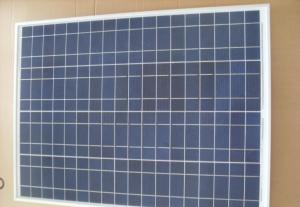Solar Panels for Heating Pools - Mono Solar Panel Modules in China
- Loading Port:
- Shanghai
- Payment Terms:
- TT OR LC
- Min Order Qty:
- 2600 watt
- Supply Capability:
- 26000 watt/month
OKorder Service Pledge
OKorder Financial Service
You Might Also Like
Specification
We now provide
• Monocrystalline Solar Panel
• Polycrystalline Solar Panel( multicrystalline silicon Solar Panel)
Features of our products:
• High conversion efficiency mono/poly-crystalline amorphous silicon solar cells
• Modules incorporate high performance bypass diodes to minimize the power drop caused by shading
• High transmittance, low-iron tempered glass
• High performance EVA encapsulant to prevent destroying and water.
• AI frame: without screw, corner connection. 8 holes on the frame can be installed easily
• Good performance of preventing from atrocious weather such as wind and hails
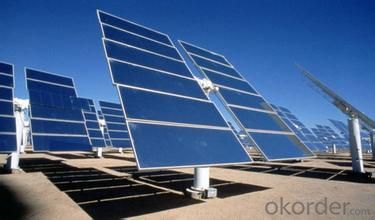
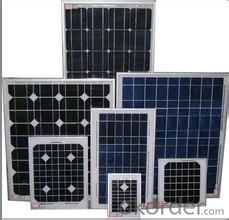
Polycrystalline Silicon Solar Modules 48Cell-195W Specification
ELECTRICAL PERFORMANCE | |||
Power output | P max | W | 195 |
Power output tolerances | ΔP max | W | 0/+5 |
Module effi ciency | η m | % | 14.7 |
Voltage at Pmax | V mpp | V | 23.7 |
Current at Pmax | I mpp | A | 8.03 |
Open-circuit voltage | V oc | V | 30.1 |
Short-circuit current | I sc | A | 8.65 |
Product Description:
This installation Manual contains essential information for the electrical and mechanical installation that your must know before installing CUSTOMER PV modules. This also contains safety information you need to be familiar with .All the information described in this manual are the intellectual property of CNBM and based on the technologies and experiences that have been acquired and accumulated in the long history of CUSTOMER. This document does not constitute a warranty, expressed or implied.
CUSTOMER does not assume responsibility and expressly disclaims liability for loss, damage, or expense arising out of in anyway connected with installation, operation, use or maintenance of the PV modules. No responsibility is assumed by CUSTOMER for any infringement of patents or other rights of third parties that may result from use of PV module.
CUSTOMER reserves the right to make changes to the product, specifications or installation manual without prior notice.
Solar panel working process
In addition to being the ultimate source of all life on earth, the sun is an infinitely renewable, completely pollution-free source of electricity. Instead of burning fossil fuels dug up from the ground in a big power plant – a very 19th century, industrial age approach, when you think about it – solar panels convert sunlight directly into electricity, with no harmful emissions.
The basic unit of a solar panel is a solar cell, which usually consists of one or two layers of silicon-based semiconductor wafers. When struck by the photons in sunlight, the solar cell generates an electrical charge due to the "photovoltaic effect" – which is a pretty good name, since it produces voltage from photons. The flow of these electrons moves in a steady electrical current from one side of the cell to the other.
Dozens of these PV cells are packaged together into solar modules, which in turn are packaged into solar panels that are mounted on a rooftop and arranged to maximize their hours of exposure to direct sunlight. Because the electricity generated by all those solar cells is direct current (DC), it is then sent to an inverter that transforms the power into the same alternating current (AC) used by the appliances in your home and the local utility electricity distribution grid. Increasingly, these inverters are getting "smart," providing data monitoring for solar installation performance and other grid integration services.
FAQ
We have organized several common questions for our clients,may help you sincerely:
Yes, we can, we have two companies for solar region, one is CNBM International, the other is CNBM engineering Co.
We can provide you not only the solar module but also the off grid solar system, we can also provide you service with on grid plant.
④What is your warranty system?
Our product performance guarantees for 25 years
• 12 years guarantee for workmanship
• Timeliness of delivery
• Quality Products certified (TÜV, UL, CE, ISO)
⑤How do you pack your products?
We have rich experience on how to pack the panels to make sure the safety on shipment when it arrives at the destination.
- Q: solar energy
- Solar panel is laminated with several materials, such as toughened glass, solar cells, EVA glue, backsheet, and mounting bracket.
- Q: is this fact true? - its a limitation to solar panels during summer when it's in extremly hot countrie. I've heard it from my science teacher .. please give detail if you have any and any more benefits/limitations is welcomed .. Thank you :) !
- WHAT? This is far from the truth, IN Scottsdale Arizona a small apartment complex was fitted with solar {photo voltaic cells in the late 70s. Every summer they sold electricity back to the power company. It gets up to 5 fairly often here, and as hot as 23 in the shade. On a roof top it is over 50 in direct sunlight. The opposite is true. When it is cloudy they produce less electricity. They may loose some efficiency when it is very hot, but not enough to make them not work at all, or even enough to really harm the output to any really appreciable extent. A new plastic photovoltaic material that produces about 40-45% of a silicon based solar cell is a neat option as it works when it is very cloudy, you can drive nails through it, and it is flexible. I think these items are kept artificially expensive by big business, but this is just a biased opinion of mine, but as far as not working in extreme heat, NO these solar panels work just fine when it is hot. I am in Phoenix Arizona, and it does not get a whole lot hotter than here. If the cells from the 970s worked OK newer ones are better and will do just fine too. Solar hot water heaters are a slightly different matter as they will over heat the water and the water must be mixed with cooler water, or you can really get into trouble. Maybe this is what he meant. Still I doubt it is enough of an issue to cause the device to be less efficient than a gas water heater, or electric, etc. Maybe he is referring to having to mix cooler water into solar heated water in a solar hot water heater, or some other system, Photovoltaic cells do not have any problems rendering them useless from hot weather on this planet, and in fact, they are used in space and it gets much hotter there.
- Q: Hi, I want to put some solar light in my yard, and wondering if a 00w solar panel could work for a few 3w dc lights....do i need a battery so they run at night, if so how many lights do u think i can run/ also i see elading solar light
- 3 w for 2 hours/night is 36 watt hours. You'll get about 500 watt hours/day from your panel on the average, which for a 2 volt battery is about 40 ampere hours. You can get an 80 amp-hour sealed gel cell battery to charge with this panel (with a suitable charge controller). You want to size your lights so the battery can provide three days of light without discharging it more than 50%, so that's abnout 600 watt-hours/3/36 = about 4 orf 5 lights. Cost for this system woulkd be over $500. The advantage of the self contained light is they use a lithium or nickel battery rather than a lead acid, so it can run totally dead without damage (unmlike a sealed lead-acid battery). That would be a far cheaper way to go. DK
- Q: Can solar panels be used for powering water treatment plants?
- Yes, solar panels can be used for powering water treatment plants. Solar energy can be harnessed and converted into electricity to operate the various processes involved in water treatment, such as filtration, disinfection, and pumping. This renewable energy source can help reduce reliance on fossil fuels, lower operational costs, and contribute to a more sustainable and environmentally-friendly water treatment process.
- Q: I was wondering if they create other forms of energy besides electrical that is unwanted. Like heat due to the friction of something, or sound. Also why is a solar panel not able to collect 00% of the energy that is striking its panels. And how could the efficiency of this be hypothetically improved.
- Science. The best solar panels we have only get like 22% of the sunlight for conversion into energy. That is simply the best they know how to make with current technology. And for that your talking about a mobile panel that tracks the sun as it moves at the equator. A solar panel in say Canada is lucky to get 0% even on a sunny day. But even if a solar panel got 00% efficiency, it's still not a lot. Sunlight is too diffuse to be a good power source, and you'd need to cover lots of ground to get power. Worse, you can only get power when the sun is out during the day. So for power at night you'd need a battery, or another source of power. The 'newest' idea is to capture sunlight to make 'lasers' that boil water, to turn turbines and make electricity. They cost way more then they are worth right now though...
- Q: Say if i had a 2KW system is thtat just one big solar panel or does the whole system have little solarpanels together.?
- Solar panels are arrays of individual solar cells connected in series and parallel, and.. A high quality, monocrystalline silicon solar cell, at 25 °C cell temperature, may produce 0.60 volts open-circuit (Voc). The cell temperature in full sunlight, even with 25 °C air temperature, will probably be close to 45 °C, reducing the open-circuit voltage to 0.55 volts per cell. The voltage drops modestly, with this type of cell, until the short-circuit current is approached (Isc).
- Q: What are the maintenance requirements for solar panels?
- The maintenance requirements for solar panels include occasional cleaning to remove dirt and debris, checking for any damage or loose connections, and ensuring that the panels are receiving sufficient sunlight. Additionally, regular monitoring of the system's performance and scheduling professional inspections can help identify and address any potential issues.
- Q: DIY, buying solar panels, room is barely 200 sq. ft. have a 5000 btu air conditioner, how many watts do I need, thinking of buying 75 watt solar panels, have space on the roof.
- Build okorder /
- Q: I wanna start going green, you know like solar panels, wind turbines, etc. but where I live the companies that install the free solar panels in exchange for the subsidiaries aren't available. To start off I was just looking for a single panel I could drill into my roof and wire it to an outlet just for small thinks like charging my phone and a fan maybe. If anybody can understand my crazy idea please answer with links to where I can find these things. Thanks!
- That's okorder /
- Q: How do solar panels affect the property's corporate social responsibility?
- Solar panels can positively impact a property's corporate social responsibility by reducing its carbon footprint and dependence on fossil fuels. By generating clean and renewable energy, solar panels help mitigate climate change and contribute to a more sustainable future. This proactive step towards environmental stewardship can enhance the property's reputation, attract environmentally conscious stakeholders, and align with the broader goals of corporate social responsibility.
Send your message to us
Solar Panels for Heating Pools - Mono Solar Panel Modules in China
- Loading Port:
- Shanghai
- Payment Terms:
- TT OR LC
- Min Order Qty:
- 2600 watt
- Supply Capability:
- 26000 watt/month
OKorder Service Pledge
OKorder Financial Service
Similar products
Hot products
Hot Searches
Related keywords
